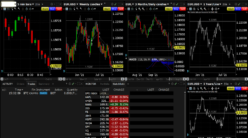
The foreign exchange (Forex) market is one of the largest and most liquid financial markets in the world. It plays a crucial role in facilitating international trade, investment, and the exchange of currencies for both businesses and individuals. At the heart of the Forex market are the major currency pairs, which represent the most traded currencies globally. Grasping the dynamics of these pairs and what influences their movements is crucial for traders of all experience levels.
The Most Traded Major Currency Pairs
Several currency pairs dominate the Forex market, known as the “majors,” which are the most traded globally. These pairs typically see the highest volumes. Let’s explore each of these pairs and their influencing factors.
EUR/USD (Euro/US Dollar)
The EUR/USD is the most widely traded currency pair globally, reflecting the value of the Euro relative to the US Dollar. It makes up roughly 20% of total Forex trading volume. Influencing factors include economic conditions in the Eurozone and the US, interest rate differences between the European Central Bank (ECB) and the Federal Reserve, and geopolitical events. For example, if the US economy grows faster than the Eurozone’s, the USD strengthens against the Euro.
USD/JPY (US Dollar/Japanese Yen)
The USD/JPY pair is heavily influenced by both US and Japanese economic conditions. The Japanese Yen is a “safe-haven” currency, often bought during global uncertainty. The Bank of Japan’s monetary policies, particularly interest rates and quantitative easing, also significantly impact the pair. The USD generally outperforms the Yen when global interest rates rise.
GBP/USD (British Pound/US Dollar)
Known as “Cable,” the GBP/USD pair is shaped by the UK’s economic performance, including trade balance, inflation, and employment data. Political events like Brexit have shown how shifts in the political landscape can influence the pair. Traders need to stay informed about UK government policies, especially trade-related ones, as these can cause substantial fluctuations.
AUD/USD (Australian Dollar/US Dollar)
The AUD/USD pair indicates the value of the Australian Dollar in relation to the US Dollar. Given Australia’s strong dependence on exports, especially commodities such as coal, iron ore, and gold, the Australian Dollar is highly responsive to fluctuations in global commodity prices. When these prices increase, the AUD tends to strengthen, whereas declines often lead to depreciation. Additionally, monetary policy decisions by the Reserve Bank of Australia, particularly regarding interest rates, significantly influence the currency’s movement.
USD/CHF (US Dollar/Swiss Franc)
Often seen as a safe-haven trade, the USD/CHF pair is influenced by economic uncertainty. Switzerland’s political stability and the Swiss Franc’s status as a “safe-haven” currency make this pair popular during times of market turbulence. The Swiss National Bank (SNB) also affects the Swiss Franc’s value through its monetary policies, including interest rate changes and market interventions.
USD/CAD (US Dollar/Canadian Dollar)
The USD/CAD pair reflects the value of the US Dollar against the Canadian Dollar. Canada’s reliance on oil exports means that the Canadian Dollar is closely tied to crude oil prices. When oil prices rise, the CAD strengthens against the USD, and when they fall, the opposite happens. The Bank of Canada’s monetary policies and economic data, such as inflation and employment figures, also impact this pair.
Factors Influencing Major Currency Pairs
Major currency pairs are influenced by various economic and geopolitical factors:
- Economic Indicators: Data such as GDP growth, inflation, and employment reports give insights into an economy’s health. Strong growth and low unemployment generally strengthen a currency, while high inflation and weak growth can cause depreciation.
- Geopolitical Events: Political factors like elections, trade negotiations, and conflicts impact currency values. Stability tends to support currencies, while uncertainty, such as Brexit, often leads to volatility.
- Central Bank Policies: Central banks, including the Federal Reserve and the ECB, influence currencies through interest rate decisions and monetary policies. For example, rate hikes typically strengthen a currency, while rate cuts can weaken it.
- Market Sentiment: Trader sentiment plays a significant role. Positive outlooks can lead to currency appreciation, while uncertainty may push traders toward safe-haven assets like the Swiss Franc or Japanese Yen.
Trading Major Forex Pairs: Strategies and Considerations
To navigate major currency pairs effectively, traders must use a variety of strategies and risk management techniques. Here are some key strategies and considerations to keep in mind.
Risk Management
Managing risk is a crucial aspect of trading major currency pairs. Traders use tools like stop-loss orders to limit potential losses and position sizing to ensure they do not risk too much on any single trade. Understanding market volatility and adjusting trade sizes accordingly is essential for protecting capital.
Using Leverage Wisely
Leverage allows traders to control larger positions with a smaller amount of capital. While it can magnify profits, it also increases the potential for losses. Therefore, traders should use leverage cautiously and understand the risks associated with it.
Timing the Market
The best time to trade major currency pairs is when there is high liquidity, typically during the overlap of major global trading sessions (such as London and New York). These times often lead to greater volatility, providing more trading opportunities.
Conclusion
Understanding the major forex pairs is a crucial step for anyone looking to navigate the dynamic world of currency trading. With their high liquidity, lower spreads, and substantial market impact, these pairs are ideal for traders seeking stability and predictable patterns. By staying informed about the key economic indicators and global events that influence these currencies, traders can make better decisions and optimize their trading strategies. To explore more about forex trading and start your journey, visit the official site for resources and tools to enhance your trading experience.





